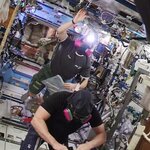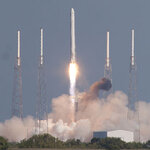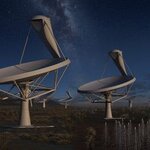Aerospace

Credit: International Space Station
By Monica Grady, The Open University
As a headline, “No gas leak on the International Space Station” ranks alongside recent news stories, such as “Mild earthquake in North Texas – no damage reported” and “No-one hurt in bedroom fire”. But behind what, thankfully, seems to be a non-story, lies a salutary tale of the problems which can arise in an environment where everything relies on computer control.
Early in the morning on January 14, the International Space Station (ISS) crew members were directed to don masks and evacuate the main control part of the…

Picture this scenario: A politician is appointed to run NASA who thinks its budget is too high and then half its money and a third of its workforce is on its way to evaporating. Public support for a mission to Mars is nonexistent.
It must be in late 2015, after anti-science Republican Senator Ted Cruz of Texas has control of NASA, if you read science media (and then whatever Huffington Post and Slate are).
The Golden Age of Space Exploration That Wasn't
But it was actually 1973. In 1973, the only thing that had less support than NASA among the public was foreign aid. You know, giving our…

In space no one can hear you bleed, but what about on a private spacecraft?
The commercial aviation industry has medical care standards, as does NASA for traditional space missions. Eventually someone is going to tell Elon Musk and Richard Brandon that the commercial space transportation industry will need to define medical care practices as well.
There are well-known risks, of course, but there can be disclaimers 400 pages long and if an attorney stands in front of a jury and talks about what lax safety standards there are, someone with the passionate pleading skill of John Edwards…

Giving it a go... EPA
By Angelo Niko Grubišić, University of Southampton
SpaceX is attempting a huge feat in spacecraft engineering.
It is seeking to land the first stage of its Falcon 9-R rocket on a floating platform at sea. Normally this would end up at the bottom of the ocean. If successful, SpaceX will shake the rocket launch market, by shaving millions of dollars off launch costs.
Whatever the outcome, the launch represents the culmination of a number of remarkable achievements in rocket science. It marks new developments in restarting rocket engines, orientation control, guidance and…

A new study shows that plasma waves buffeting the planet's radiation belts are responsible for scattering charged particles into the atmosphere, creating the most detailed analysis so far of the link between these waves and the fallout of electrons from the planet's radiation belts.
The belts are impacted by fluctuations in "space weather" caused by solar activity that can disrupt GPS satellites, communication systems, power grids and manned space exploration.
The Van Allen radiation belts are donut-shaped belts of charged particles held in place by the Earth's magnetosphere, the magnetic…

Despite a malfunction that ended its primary mission in May 2013, the Kepler spacecraft is still alive and working and its data has found a new "super-Earth".
NASA's Kepler spacecraft detected planets by looking for transits, when a star dims slightly as a planet crosses in front of it. The smaller the planet, the weaker the dimming, so brightness measurements must be precise and that requires maintaining a steady pointing. Kepler can't really do that any more, its primary functionality came to an end when the second of four reaction wheels used to stabilize the spacecraft failed. Without at…

With the successful flight test of NASA's Orion spacecraft on Dec. 5, a new space era for has started for America and its aerospace industry. Companies engaged in space exploration like Lockheed Martin, which built the Orion spacecraft, learn a valuable lesson from this first and crucial step on a long journey to Mars.
In times of U.S. reliance on other countries regarding spaceflight, this lesson is also a major step forward to an independent homegrown space engineering. In an interview with astrowatch.net, Lockheed Martin spokesperson, Allison Rakes, talks Orion's milestone test flight.…

Scientists have calculated that asteroid 2014 UR116 will fly in dangerous proximity to Earth every three years. If it collides with the planet the energy of the explosion could be a thousand times greater than the impact of the Chelyabinsk meteorite. Vladimir Lipunov, a leading scientist on the team which discovered the asteroid this October, says the scientists now know its orbit and its period which is 3 years, but they cannot say precisely when the asteroid will approach the Earth. “We should track it constantly. Because if we have a single mistake, there will be a catastrophe.
The…

Artistic rendering of the Square Kilometre Array at night. SKA Organisation
By Yves Wiaux, Heriot Watt University and Jason McEwen, University College London
Telescopes have come a long way since the days when they were all about lone astronomers watching the night sky through their upstairs windows. Today teams of astrophysicists build and use much more modern instruments, not only to observe light visible to our eyes, but also radio emissions from the universe.
Radio telescopes used to use large single dishes to pick up these emissions, but have since graduated to arrays of antennae. These…

America embarks on a long-lasting trip to Mars this Thursday. Orion’s maiden flight, Exploration Flight Test-1 (EFT-1), slated to test spacecraft’s crucial systems is a critical first step on our journey to destinations beyond Earth never before visited by humans, like asteroids and Mars. “Everyone is very excited about this mission,” Stephanie Schierholz, NASA spokesperson told me. “Orion’s flight test is a critical step on NASA's journey to Mars.” In the future, Orion will launch on NASA’s new heavy-lift rocket, the Space Launch System (SLS). The rocket will be capable of sending humans to…